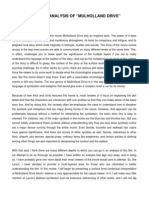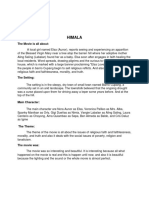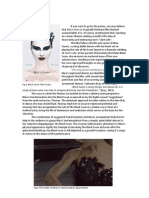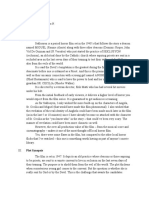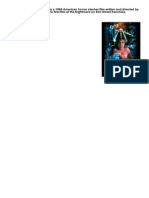The Ward
The Ward
Uploaded by
harps777Copyright:
Available Formats
The Ward
The Ward
Uploaded by
harps777Original Description:
Copyright
Available Formats
Share this document
Did you find this document useful?
Is this content inappropriate?
Copyright:
Available Formats
The Ward
The Ward
Uploaded by
harps777Copyright:
Available Formats
The Ward Analysis
The Ward is a 2010 American psychological horror film directed by John Carpenter. It stars Amber Heard, Danielle Panabaker, Mika Boorem, and Jared Harris. It is Carpenter's first fulllength feature film since Ghosts of Mars in 2001. A thriller centered on an institutionalized young woman (Amber Heard) who becomes terrorized by a ghost. Arc Entertainment. In the opening sequence I can see that non diegetic sound first of all it is a subtle woman against a slow beat tune. Violins are playing also. This creates suspense and appeals to the audience because the music almost sounds angelic and holy. This is a common sub-genre of horror, religion can play a big part therefore it gives the audience an idea of what the film might include. Whilst the music is playing we can see religious imagery from the bible. It is of a woman being tied up and men poking her. This is a very old photo and has religious connotations with the non diegetic sound. It also ties in with Laura Mulveys theory that the male gaze is directed at the women purposely for her assets. In this scenario we can see the woman is naked on her chest and although her hair is covering her, she still can be seen as helpless and vulnerable. Also the body structure of her denotes helpless because she is tied up with various males surrounding her. What happens next is that the glass of this image shatters; the audience now realizes the image was a glass picture and also makes the audience jump. The non-diegetic sound becomes bolder and the womans voice becomes louder and more angelic. It almost sounds leering and sexual which connotes this film could involve a female antagonist or protagonist. This is still a mystery to the audience however, because they are not aware of any characters just yet. In this midshots it is of a woman in white on her knees praying with a man touching her. The man is hard to see however looking at it carefully her has long metal like nails which he is touching her forehead with. Previously the ward showed old biblical pictures and now a midshots of a woman praying. This confirms to the audience there are religious themes in this media text. The woman dressed in white connotes angelic, pure, clean and innocent. However, in this scenario her white dress looks like a wedding dress. Who is the man, is he the groom? This created suspense and mystery to the audience, why is she praying on her wedding day? Her facial expression connotes she is praying very hard, and almost possessed. The lighting of her is a sepia effect connoting this is also an old picture, however obviously not as old as the previous shot. The lighting behind her however is black. Black is a common convention of horror and death. This highlights to the audience that this could be a film regarding the dark side of religion. This is appealing because already
The Ward Analysis
its creating suspense and mystery, who is this woman? Why is she so entwined in prayer? Why is she wearing white and who is this man? So many questions have been created for the audience which is appealing because they are now intrigued in what is going to happen. The theme of glass is still constant and once again it is breaking on this image. Breaking glass connotes danger, shattered memories and pain. It isnt a common horror convention however used in these specific scenes the directors have made it seem so. This specific mid-shot is another interesting shot, it is once again of a woman in pain. Women are constantly being used as a victim in the opening sequence and this particular shot shows the woman being injected in the back of her head and forced because someone is holding her head. The lighting is black and white however quite clear and contrasted, this implies a clarity and clear image that the directors intention was for the audience to see the situation this woman is in. Compared to the last shot it is clearer because the characters are easier to see. Glass is once again being a consistent factor in the several shots. Throughout the shots so far this is quite a confusing horror, there have not been the usual codes nor conventions of a typical horror film although we do particularly get idea of what sort of sub-genre it is. From the unusual pictures and religious links we can tell this could be a pyscological film, due to the bizzare scenes Carpenter uses. In this particular shot, we get sense of a typical horror character. A young white women with blonde hair is most usually a victim in every other horror movie. Her naked self also gives sense of the Laura Mulvey theory because she is naked. The male gaze suggests men only look at women for sexual pleasure and in this sense the film most definitely agrees with Mulveys perception. Also, the shadow behind the female connotes a masculine male, once again Mulveys correct because this connotes the blonde young female is the victim. Overall, I believe Carpenter uses strong lighting, reference to religious and metaphorical glass as symbolism as major aspects to this intriguing and unusal physchological horror.
You might also like
- Ultimate Beginner's Guide To Midjourney V6 ParametersDocument58 pagesUltimate Beginner's Guide To Midjourney V6 ParametersRachit100% (5)
- Wedding Welcome PacketDocument23 pagesWedding Welcome PacketKristin DeMarco100% (1)
- Leeming LUT One Sony Cameras Combined SetupDocument5 pagesLeeming LUT One Sony Cameras Combined SetupKyle WatsonNo ratings yet
- Sample Semi Detailed OBE Lesson PlanDocument2 pagesSample Semi Detailed OBE Lesson PlanJude Salayo OaneNo ratings yet
- Talk Like An ArtistDocument44 pagesTalk Like An Artistwenjie zhangNo ratings yet
- A Multi-Layered Analysis of Mulholland DriveDocument114 pagesA Multi-Layered Analysis of Mulholland DriveIWantToBelieve8728No ratings yet
- The Personality of Nina Sayers in Darren Aronofsky's Black Swan - A Psychoanalytic Approach PDFDocument62 pagesThe Personality of Nina Sayers in Darren Aronofsky's Black Swan - A Psychoanalytic Approach PDFRizwana RahumanNo ratings yet
- SELFIE ScreenplayDocument9 pagesSELFIE ScreenplayMahesh KathiNo ratings yet
- Black Swan EssayDocument10 pagesBlack Swan EssayNancy GuanNo ratings yet
- Black Swan' Trailer AnalysisDocument9 pagesBlack Swan' Trailer AnalysisalissyrussellNo ratings yet
- Maksutov-Newtonian MN190 PDFDocument2 pagesMaksutov-Newtonian MN190 PDFcarrierNo ratings yet
- Role of EXPRESSION in Art MakingDocument15 pagesRole of EXPRESSION in Art MakingJohn Robert GasbanNo ratings yet
- Evaluation 2Document2 pagesEvaluation 2Jack edmondsNo ratings yet
- Evil Dead AnalysisDocument3 pagesEvil Dead Analysisharps777No ratings yet
- Jennifers Body Feminism EssayDocument3 pagesJennifers Body Feminism EssayzoelinguaNo ratings yet
- Halloween (John Carpenter, 1978) Questions: TH THDocument2 pagesHalloween (John Carpenter, 1978) Questions: TH THlilymaelandellNo ratings yet
- Horror Genre PosterDocument4 pagesHorror Genre Posterapi-273816958No ratings yet
- Black Narcissus (1947)Document5 pagesBlack Narcissus (1947)Anim MANo ratings yet
- Opening Sequence PowerpointDocument10 pagesOpening Sequence Powerpointemyy.hawesNo ratings yet
- Opening Sequence PowerpointDocument11 pagesOpening Sequence Powerpointemyy.hawesNo ratings yet
- Treatment - Sleep TightDocument2 pagesTreatment - Sleep TightBeckyWholleyNo ratings yet
- Part FiveDocument6 pagesPart Fiveebun_ewedemiNo ratings yet
- Pitch - Anonymous FinalDocument12 pagesPitch - Anonymous Finalapi-333911122No ratings yet
- Short Film Analysis: UnwindDocument4 pagesShort Film Analysis: UnwindWilhelminaDennessNo ratings yet
- Scott James AS Media Candidate Number: 1105 Centre Number: 26200Document2 pagesScott James AS Media Candidate Number: 1105 Centre Number: 26200Scottaj98No ratings yet
- Psychoanalytical Approach - The Black SwanDocument5 pagesPsychoanalytical Approach - The Black SwanIvy NiebresNo ratings yet
- Himala: Ronnel J. Agustin BSA 2-5Document2 pagesHimala: Ronnel J. Agustin BSA 2-5Mylene Sunga AbergasNo ratings yet
- Black Swan (2010) Film ReviewDocument2 pagesBlack Swan (2010) Film ReviewsbpayneNo ratings yet
- Project in The Course of FLM 620 Theory of Sound in Film: Klute, A Sound AnalysisDocument9 pagesProject in The Course of FLM 620 Theory of Sound in Film: Klute, A Sound AnalysisEdward TannousNo ratings yet
- Evaluation 2Document21 pagesEvaluation 2mariahamerNo ratings yet
- InsidiousDocument2 pagesInsidiousuahproductions100% (1)
- Black Swan AnalysisDocument16 pagesBlack Swan AnalysisDanielle MarquezNo ratings yet
- Thriller Essays (Ronin)Document7 pagesThriller Essays (Ronin)Danielle345No ratings yet
- In What Ways Does Your Media Product Use, Develop, or Challenge Forms and Conventions of Real Media Products?Document13 pagesIn What Ways Does Your Media Product Use, Develop, or Challenge Forms and Conventions of Real Media Products?katiebrockisNo ratings yet
- Film Final Rustin PlayerDocument7 pagesFilm Final Rustin Playerapi-253526312No ratings yet
- Psychological Analysis of The Black Swan CharacterDocument15 pagesPsychological Analysis of The Black Swan CharacterScribdTranslationsNo ratings yet
- Evaluation 2Document2 pagesEvaluation 2Jack edmondsNo ratings yet
- In What Ways Does Your Media Product Use, Develop or Challenge Forms and Conventions of Real Media Products?Document8 pagesIn What Ways Does Your Media Product Use, Develop or Challenge Forms and Conventions of Real Media Products?aliceNo ratings yet
- Critique Paper 2 - Movie ReviewDocument3 pagesCritique Paper 2 - Movie ReviewJannie LeilaNo ratings yet
- Question 1Document5 pagesQuestion 1SaraNo ratings yet
- InsidiousDocument2 pagesInsidiousuahproductionsNo ratings yet
- How Does Your Media Product Represent Particular Social Groups?Document9 pagesHow Does Your Media Product Represent Particular Social Groups?aliceNo ratings yet
- Chapel Lane EvaluationDocument8 pagesChapel Lane EvaluationmarthahillsNo ratings yet
- Le Belle Et La Bête Film ReviewDocument6 pagesLe Belle Et La Bête Film ReviewGrace Sansbury ChanceNo ratings yet
- Production Aims FInalDocument2 pagesProduction Aims FInalsophieNo ratings yet
- Gender Represntation in Horror CompleteDocument4 pagesGender Represntation in Horror Completeapi-438290497No ratings yet
- The StrangersDocument36 pagesThe StrangerslarafalzonNo ratings yet
- Album Cover AnalysisDocument2 pagesAlbum Cover AnalysisJasLizMay100% (1)
- Repulsion (1965) - Film Review Louis BeldenDocument4 pagesRepulsion (1965) - Film Review Louis BeldenLegendof LouisNo ratings yet
- 28 Days Later 1 2 1 1 1Document3 pages28 Days Later 1 2 1 1 1api-298504424No ratings yet
- 'Female Competition & The Male Gaze: Is 'The Neon Demon' A Feminist Text?'Document11 pages'Female Competition & The Male Gaze: Is 'The Neon Demon' A Feminist Text?'Jonathan FoulstonNo ratings yet
- Psycho AnalysisDocument3 pagesPsycho AnalysisNatasha ShadatNo ratings yet
- The Endings: Photographic Stories of Love, Loss, Heartbreak, and Beginning AgainFrom EverandThe Endings: Photographic Stories of Love, Loss, Heartbreak, and Beginning AgainNo ratings yet
- Guardians of The Galaxy: Opening Scene Analysis by Lydia FlanniganDocument9 pagesGuardians of The Galaxy: Opening Scene Analysis by Lydia FlanniganLydia FlanniganNo ratings yet
- Evaluation: by Lauren PicotDocument18 pagesEvaluation: by Lauren PicotlaurenNo ratings yet
- The Stepford Wives Media Analysis Paper2Document14 pagesThe Stepford Wives Media Analysis Paper2api-485611322No ratings yet
- Essay - Final DraftDocument6 pagesEssay - Final DraftJanetJayNo ratings yet
- The Color PurpleDocument6 pagesThe Color PurpleSilviana Suciu100% (1)
- OrphanDocument8 pagesOrphanapi-278273062No ratings yet
- Let Me inDocument2 pagesLet Me inYancia JenciNo ratings yet
- Evaluation Question 1 of Main TaskDocument8 pagesEvaluation Question 1 of Main TaskniamhcarrNo ratings yet
- Carrie DianaVictoriaBanuDocument7 pagesCarrie DianaVictoriaBanuDiana-Victoria BanuNo ratings yet
- Question 1Document11 pagesQuestion 1api-276308962No ratings yet
- DoubtDocument3 pagesDoubtcarmelajoyce.11No ratings yet
- Woman in Black Gcse CourseworkDocument8 pagesWoman in Black Gcse Courseworkafaydebwo100% (2)
- Kill Bill Narrative AnalysisDocument2 pagesKill Bill Narrative Analysisapi-239003591No ratings yet
- I Spit On Your Celluloid: The History of Women Directing Horror MoviesFrom EverandI Spit On Your Celluloid: The History of Women Directing Horror MoviesNo ratings yet
- Final Treatment - RunawayDocument2 pagesFinal Treatment - Runawayharps777No ratings yet
- Storyboard: This Is My Storyboard For My Short FilmDocument5 pagesStoryboard: This Is My Storyboard For My Short Filmharps777No ratings yet
- Social Realism Directors Case StudyDocument5 pagesSocial Realism Directors Case Studyharps777No ratings yet
- Wasp Case StudyDocument4 pagesWasp Case Studyharps777No ratings yet
- What's Virgin Mean - AnalysisDocument4 pagesWhat's Virgin Mean - Analysisharps777No ratings yet
- Joy of DestructionDocument5 pagesJoy of Destructionharps777No ratings yet
- Treatment - Gilted: Nasima and HarpreetDocument1 pageTreatment - Gilted: Nasima and Harpreetharps777No ratings yet
- Initial IdeasDocument1 pageInitial Ideasharps777No ratings yet
- Horror TreatmentDocument2 pagesHorror Treatmentharps777No ratings yet
- Representation in Zombie FilmsDocument5 pagesRepresentation in Zombie Filmsharps777No ratings yet
- Rich Text Editor FileDocument1 pageRich Text Editor Fileharps777No ratings yet
- Photography Composition Using The Elements and Principles of DesignDocument15 pagesPhotography Composition Using The Elements and Principles of Designapi-309416438No ratings yet
- Street ArtDocument18 pagesStreet Artapi-307608756No ratings yet
- Relative Clauses1Document3 pagesRelative Clauses1Javier Alexander JURADO BENITEZNo ratings yet
- FUJi FILMDocument3 pagesFUJi FILMNoveliaNo ratings yet
- Concilio On Teju ColeDocument20 pagesConcilio On Teju ColeMahdokht RsNo ratings yet
- DF96 18OZ Instructions - CompleteDocument2 pagesDF96 18OZ Instructions - CompleteAndrea J. NasiNo ratings yet
- Photographylife Com Types of PhotographyDocument14 pagesPhotographylife Com Types of Photographymkdir911No ratings yet
- Nikon D3300Document15 pagesNikon D3300martens5No ratings yet
- About Canon IndiaDocument82 pagesAbout Canon IndiaManoj Kumar BNo ratings yet
- MAPEH10 - ARTS Q1 Module 2 Characteristics of Art Movements V3 1 PDFDocument54 pagesMAPEH10 - ARTS Q1 Module 2 Characteristics of Art Movements V3 1 PDFErich CaviteNo ratings yet
- Color: How To Push, Pull, and Balance Space: The Use of Colors ValuesDocument76 pagesColor: How To Push, Pull, and Balance Space: The Use of Colors ValuesOluwafunmibi FasinaNo ratings yet
- inkBOOK Classic2 Prime PDFDocument92 pagesinkBOOK Classic2 Prime PDFZuzannaNo ratings yet
- Karen Beckman - Animating Film Theory-Duke University Press (2014)Document370 pagesKaren Beckman - Animating Film Theory-Duke University Press (2014)Rima Gtari100% (2)
- Cosina CSM: Click Here To Go To Main Camera Manual SiteDocument8 pagesCosina CSM: Click Here To Go To Main Camera Manual SitePati GualterosNo ratings yet
- Commercial PhotographyDocument12 pagesCommercial Photographyapi-394443105No ratings yet
- Optics: Determining The Focal Lengths at Collecting and Dispersing Lenses Using Collimated LightDocument2 pagesOptics: Determining The Focal Lengths at Collecting and Dispersing Lenses Using Collimated LightAlejandro CardenasNo ratings yet
- Accordion PDFDocument9 pagesAccordion PDFFlavio GhettiNo ratings yet
- CoC - Now Adv - Dinner With Susan PDFDocument5 pagesCoC - Now Adv - Dinner With Susan PDFLuca LiperiNo ratings yet
- Avenue Patrice Lumumba - Lese - 1Document24 pagesAvenue Patrice Lumumba - Lese - 1Gabriela GaiaNo ratings yet
- OceanofPDF - Com How I Fall - Anne Eliot PDFDocument326 pagesOceanofPDF - Com How I Fall - Anne Eliot PDFErika Mae LibangNo ratings yet
- Lumix DMC-FZ40 PDFDocument44 pagesLumix DMC-FZ40 PDFb08iktNo ratings yet
- Brief History of The Invention of PhotographyDocument1 pageBrief History of The Invention of PhotographyHrittika DasNo ratings yet





